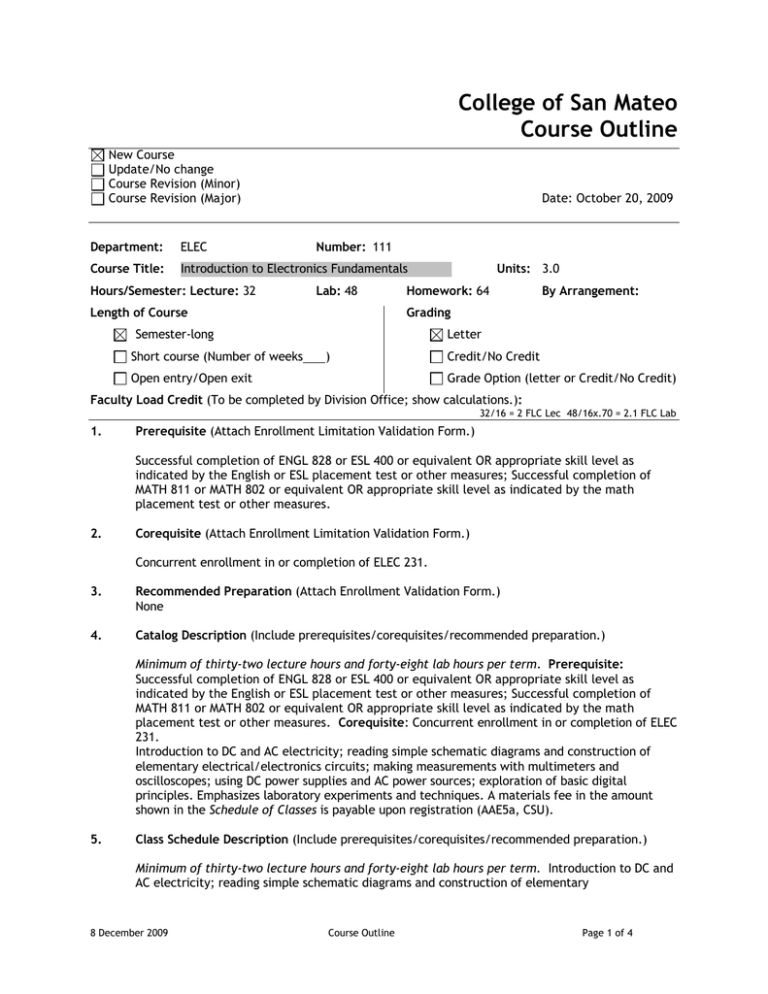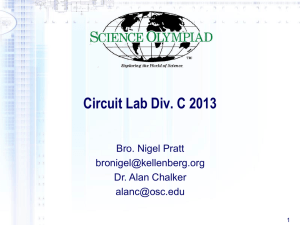College of San Mateo Course Outline
advertisement

College of San Mateo Course Outline New Course Update/No change Course Revision (Minor) Course Revision (Major) Date: October 20, 2009 Department: ELEC Course Title: Introduction to Electronics Fundamentals Hours/Semester: Lecture: 32 Number: 111 Lab: 48 Length of Course Homework: 64 By Arrangement: Grading Semester-long Short course (Number of weeks Units: 3.0 Letter ) Open entry/Open exit Credit/No Credit Grade Option (letter or Credit/No Credit) Faculty Load Credit (To be completed by Division Office; show calculations.): 32/16 = 2 FLC Lec 48/16x.70 = 2.1 FLC Lab 1. Prerequisite (Attach Enrollment Limitation Validation Form.) Successful completion of ENGL 828 or ESL 400 or equivalent OR appropriate skill level as indicated by the English or ESL placement test or other measures; Successful completion of MATH 811 or MATH 802 or equivalent OR appropriate skill level as indicated by the math placement test or other measures. 2. Corequisite (Attach Enrollment Limitation Validation Form.) Concurrent enrollment in or completion of ELEC 231. 3. Recommended Preparation (Attach Enrollment Validation Form.) None 4. Catalog Description (Include prerequisites/corequisites/recommended preparation.) Minimum of thirty-two lecture hours and forty-eight lab hours per term. Prerequisite: Successful completion of ENGL 828 or ESL 400 or equivalent OR appropriate skill level as indicated by the English or ESL placement test or other measures; Successful completion of MATH 811 or MATH 802 or equivalent OR appropriate skill level as indicated by the math placement test or other measures. Corequisite: Concurrent enrollment in or completion of ELEC 231. Introduction to DC and AC electricity; reading simple schematic diagrams and construction of elementary electrical/electronics circuits; making measurements with multimeters and oscilloscopes; using DC power supplies and AC power sources; exploration of basic digital principles. Emphasizes laboratory experiments and techniques. A materials fee in the amount shown in the Schedule of Classes is payable upon registration (AAE5a, CSU). 5. Class Schedule Description (Include prerequisites/corequisites/recommended preparation.) Minimum of thirty-two lecture hours and forty-eight lab hours per term. Introduction to DC and AC electricity; reading simple schematic diagrams and construction of elementary 8 December 2009 Course Outline Page 1 of 4 electrical/electronics circuits; making measurements with multimeters and oscilloscopes; using DC power supplies and AC power sources; exploration of basic digital principles. Emphasizes laboratory experiments and techniques. A materials fee of $20 is payable upon registration. Prerequisite: Successful completion of ENGL 828 or ESL 400 or equivalent OR appropriate skill level as indicated by the English or ESL placement test or other measures; Successful completion of MATH 811 or MATH 802 or equivalent OR appropriate skill level as indicated by the math placement test or other measures. Corequisite: Concurrent enrollment in or completion of ELEC 231. (AAE5a, CSU) 6. Student Learning Outcomes (Identify 1-6 expected learner outcomes using active verbs.) Upon successful completion of the course, the student will be able to: 1. define the following terms: electron theory; conductors and insulators; voltage, current, resistance, power; electrical energy consumption, kilowatt-hour meter; resistor color-code; 2. demonstrate proper use of a scientific calculator to determine the following: series and parallel circuit values; DC and AC voltages and currents; metric prefixes and conversion factors; 3. perform calculations involving Ohm’s Law, Watt’s Law, and series/parallel/seriesparallel circuits; 4. demonstrate skill in the use of laboratory equipment: power supplies, analog and digital multimeters, function generators and oscilloscopes; 5. define and calculate the following AC values: AC power; peak-peak, peak, rms, effective, and average values; frequency, period, and wavelength; 6. define the following terms pertaining to magnetism and inductance: Inductance; Lenz’s law; inductive reactance (XL ); applications for inductors; transformers; step-up/step-down and impedance ratios; practical applications; 7. define the following terms related to capacitance: types, identification and applications; timing and filtering; unit of measurement; factors that determine the capacitance of a capacitor; capacitive reactance (Xc); RC circuit; and impedance (Z); 8. explain the purpose and function of the following semiconductor devices: diodes; transistors; integrated circuits; 9. demonstrate the use of semiconductor devices in the following circuits: power supplies; half-wave and bridge rectification circuits; digital logic circuits; 10. observe and interpret diode and transistor characteristics in typical linear power supply; 11. describe the basic digital logic elements in digital and computer-based electronics equipment: AND, OR, NOT, NAND, NOR, XOR and XNOR; 12. demonstrate the ability to combine logic gates into a working logic circuit; 13. describe typical transducers and their applications: microphones, loudspeakers, headphones, cartridges, magnet pickups and tape heads, and sensors; 14. apply concepts learned to a working electronic system: AM/FM radio, power supply, digital logic circuit (example: digital clock) 7. Course Objectives (Identify specific teaching objectives detailing course content and activities. For some courses, the course objectives will be the same as the student learning outcomes. If this is the case, please simply indicate this in this section). Same as above 8. Course Content (Brief but complete topical outline of the course that includes major subject areas [1-2 pages]. Should reflect all course objectives listed above. In addition, you may attach a sample course syllabus with a timeline.) 8 December 2009 Course Outline Page 2 of 4 1. definition of terms: electron theory; conductors and insulators; voltage, current, resistance, power; electrical energy consumption, kilowatt-hour meter; resistor color-code; (objective 1) 2. proper use of a scientific calculator to determine the following: series and parallel circuit values; DC and AC voltages and currents; metric prefixes and conversion factors; (objectives 2, 3) 3. perform calculations involving Ohm’s Law, Watt’s Law, and series/parallel/seriesparallel circuits; (objectives 2, 3) 4. demonstrate skill in the use of laboratory equipment: power supplies, analog and digital multimeters, function generators and oscilloscopes; (objective 4) 5. define and calculate the following AC values: AC power; peak-peak, peak, rms, effective, and average values; frequency, period, and wavelength; (objective 5) 6. define the following terms pertaining to magnetism and inductance: Inductance; Lenz’s law; inductance reactance (XL ); applications for inductors; transformers; step-up/step-down and impedance ratios; practical applications; (objective 6) 7. define the following terms related to capacitance: types, identification and applications; timing and filtering; unit of measurement; factors that determine the capacitance of a capacitor; capacitance reactance (Xc); RC circuit; and impedance (Z); (objective 7) 8. explain the purpose and function of the following semiconductor devices: diodes; transistors; integrated circuits; (objective 8) 9. demonstrate the use of semiconductor devices in the following circuits: power supplies; half-wave and bridge rectification circuits; digital logic circuits; (objective 8, 9, 10) 10. observe and interpret diode characteristics in typical linear power supply; (objective 8, 9, 10) 11. describe the basic digital logic elements in digital and computer-based electronics equipment: AND, OR, NOT, NAND, NOR, XOR and XNOR; (objective 11) 12. demonstrate the ability to combine logic gates into a working logic circuit; (objective 12) 13. describe typical transducers and their applications: microphones, loudspeakers, headphones, cartridges, magnet pickups and tape heads, and sensors; (objective 13) 14. apply concepts learned to a working electronic system: AM/FM radio, power supply, digital logic circuit (example: digital clock) (objective 14) 9. Representative Instructional Methods (Describe instructor-initiated teaching strategies that will assist students in meeting course objectives. Include examples of out-of-class assignments, required reading and writing assignments, and methods for teaching critical thinking skills.) a. b. c. d. e. f. 10. Lectures Handouts Homework assignments from the textbook Videos Computer based training activities Lab activities Representative Methods of Evaluation (Describe measurement of student progress toward course objectives. Courses with required writing component and/or problem-solving emphasis must reflect critical thinking component. If skills class, then applied skills.) a. b. c. d. Quizzes Examinations Homework assignments CBT results 8 December 2009 Course Outline Page 3 of 4 e. Lab activities 11. Representative Text Materials (With few exceptions, texts need to be current. Include publication dates.) Petruzella. Essentials of Electronics. Second Edition. Copyright 2001. CSM. ELEC 111 Electronics Fundamentals: Laboratory Manual and Supplemental Handouts. Prepared by: (Signature) Email address: macdonaldj@smccd.net Submission Date: October 20, 2009 8 December 2009 Course Outline Page 4 of 4






